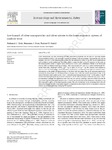Low hazard of silver nanoparticles and silver nitrate to the haematopoietic system of rainbow trout
| dc.contributor.author | Clark, Nathaniel | |
| dc.contributor.author | Shaw, BJ | |
| dc.contributor.author | Handy, Richard | |
| dc.date.accessioned | 2018-05-10T15:27:57Z | |
| dc.date.issued | 2018-05-15 | |
| dc.identifier.issn | 0147-6513 | |
| dc.identifier.issn | 1090-2414 | |
| dc.identifier.uri | http://hdl.handle.net/10026.1/11496 | |
| dc.description.abstract |
Silver nanoparticles (Ag NPs) are known for their antibacterial properties and are used in a growing number of nano-enabled products, with inevitable concerns for releases to the environment. Nanoparticles may also be antigenic and toxic to the haematopoietic system, but the immunotoxic effect of Ag NPs on non-target species such as fishes is poorly understood. This study aimed to assess the effect of Ag NP exposure via the water on the haematopoietic system of rainbow trout, Oncorhynchus mykiss, and to determine whether or not the hazard from Ag NPs was different from that of AgNO3. Fish were exposed for 7 days to a control (dechlorinated Plymouth freshwater), dispersant control, 1µgl-1 Ag as AgNO3 or 100µgl-1 Ag NPs. Animals were sampled on days 0, 4 and 7 for haematology, tissue trace metal concentration, biochemistry for evidence of oxidative stress/inflammation in the spleen and histopathology of the blood cells and spleen. The Ag NP treatment significantly increased the haematocrit, but the haematological changes were within the normal physiological range of the animal. Thrombocytes in spleen prints at day 4, and melanomacrophage deposits at day 7 in the spleen, of Ag NP exposed-fish displayed significant increases compared to all the other treatments within the time point. A dialysis experiment confirmed that dissolution rates were very low and any pathology observed is likely from the NP form rather than dissolved metal released from it. Overall, the data showed subtle differences in the effects of Ag NPs compared to AgNO3 on the haematopoietic system. The lack of pathology in the circulating blood cells and melanomacrophage deposits in the spleen suggests a compensatory physiological effort by the spleen to maintain normal circulating haematology during Ag NP exposure. | |
| dc.format.extent | 121-131 | |
| dc.format.medium | Print-Electronic | |
| dc.language | en | |
| dc.language.iso | en | |
| dc.publisher | Elsevier | |
| dc.rights | Attribution-NonCommercial-NoDerivatives 4.0 International | |
| dc.rights | Attribution-NonCommercial-NoDerivatives 4.0 International | |
| dc.rights | Attribution-NonCommercial-NoDerivatives 4.0 International | |
| dc.rights | Attribution-NonCommercial-NoDerivatives 4.0 International | |
| dc.rights | Attribution-NonCommercial-NoDerivatives 4.0 International | |
| dc.rights | Attribution-NonCommercial-NoDerivatives 4.0 International | |
| dc.rights | Attribution-NonCommercial-NoDerivatives 4.0 International | |
| dc.rights | Attribution-NonCommercial-NoDerivatives 4.0 International | |
| dc.rights.uri | http://creativecommons.org/licenses/by-nc-nd/4.0/ | |
| dc.rights.uri | http://creativecommons.org/licenses/by-nc-nd/4.0/ | |
| dc.rights.uri | http://creativecommons.org/licenses/by-nc-nd/4.0/ | |
| dc.rights.uri | http://creativecommons.org/licenses/by-nc-nd/4.0/ | |
| dc.rights.uri | http://creativecommons.org/licenses/by-nc-nd/4.0/ | |
| dc.rights.uri | http://creativecommons.org/licenses/by-nc-nd/4.0/ | |
| dc.rights.uri | http://creativecommons.org/licenses/by-nc-nd/4.0/ | |
| dc.rights.uri | http://creativecommons.org/licenses/by-nc-nd/4.0/ | |
| dc.subject | Nanomaterials | |
| dc.subject | Immunity | |
| dc.subject | Blood smears | |
| dc.subject | Spleen prints | |
| dc.title | Low hazard of silver nanoparticles and silver nitrate to the haematopoietic system of rainbow trout | |
| dc.type | journal-article | |
| dc.type | Article | |
| plymouth.author-url | http://gateway.webofknowledge.com/gateway/Gateway.cgi?GWVersion=2&SrcApp=PARTNER_APP&SrcAuth=LinksAMR&KeyUT=WOS:000427807100015&DestLinkType=FullRecord&DestApp=ALL_WOS&UsrCustomerID=11bb513d99f797142bcfeffcc58ea008 | |
| plymouth.volume | 152 | |
| plymouth.publication-status | Published | |
| plymouth.journal | Ecotoxicology and Environmental Safety | |
| dc.identifier.doi | 10.1016/j.ecoenv.2018.01.030 | |
| plymouth.organisational-group | /Plymouth | |
| plymouth.organisational-group | /Plymouth/Faculty of Science and Engineering | |
| plymouth.organisational-group | /Plymouth/Faculty of Science and Engineering/School of Biological and Marine Sciences | |
| plymouth.organisational-group | /Plymouth/REF 2021 Researchers by UoA | |
| plymouth.organisational-group | /Plymouth/REF 2021 Researchers by UoA/UoA06 Agriculture, Veterinary and Food Science | |
| plymouth.organisational-group | /Plymouth/REF 2021 Researchers by UoA/UoA07 Earth Systems and Environmental Sciences | |
| plymouth.organisational-group | /Plymouth/Research Groups | |
| plymouth.organisational-group | /Plymouth/Research Groups/Marine Institute | |
| plymouth.organisational-group | /Plymouth/Users by role | |
| plymouth.organisational-group | /Plymouth/Users by role/Academics | |
| dc.publisher.place | Netherlands | |
| dcterms.dateAccepted | 2018-01-11 | |
| dc.rights.embargodate | 2019-2-5 | |
| dc.identifier.eissn | 1090-2414 | |
| dc.rights.embargoperiod | Not known | |
| rioxxterms.versionofrecord | 10.1016/j.ecoenv.2018.01.030 | |
| rioxxterms.licenseref.uri | http://creativecommons.org/licenses/by-nc-nd/4.0/ | |
| rioxxterms.licenseref.startdate | 2018-05-15 | |
| rioxxterms.type | Journal Article/Review |



